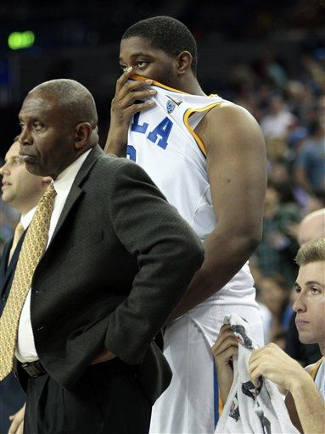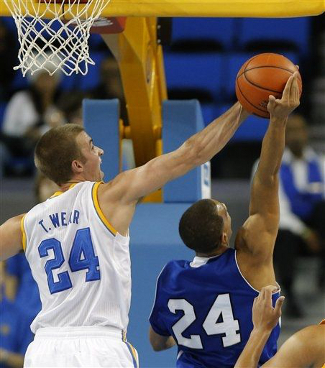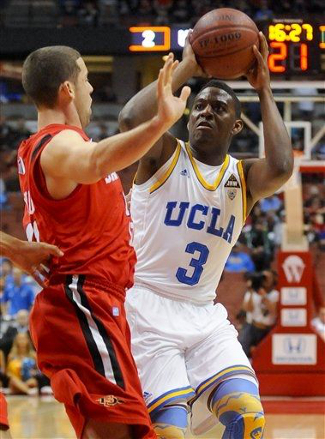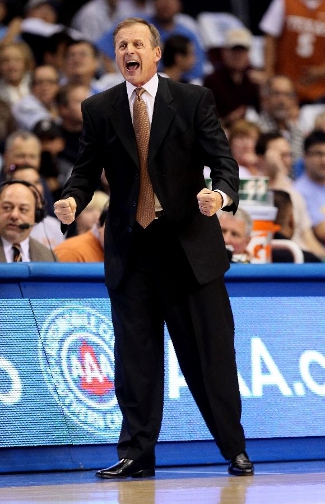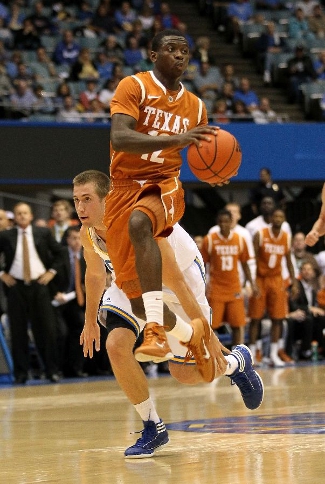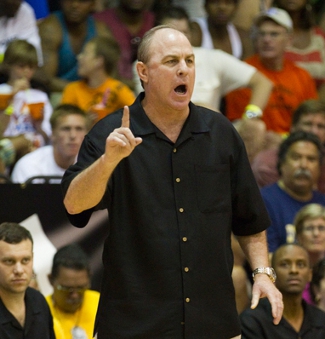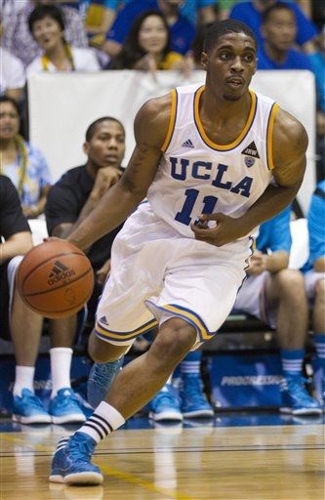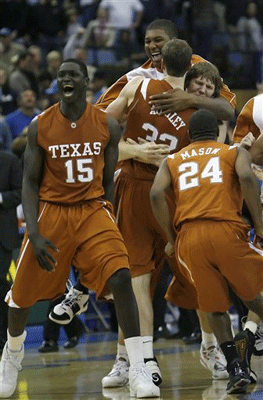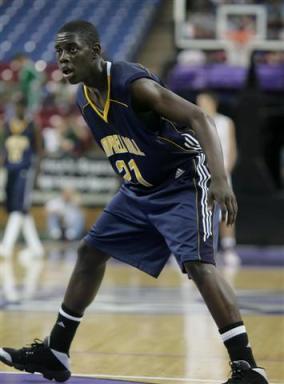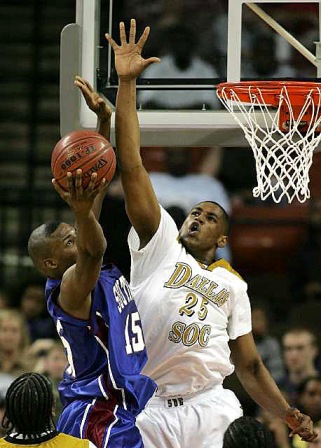Reliant Stadium | Houston, TX | Tip: Approx. 4:15 P.M. CT | TV: ESPN LRT Consecutive Game #229 Three months ago, the match-up between Texas and UCLA appeared to be one of those early-season non-conference battles that give fans an early taste of March Madness. The Bruins boasted the nation’s top recruiting class and were ranked 13th in both the Associated Press and USA Today Coaches Poll. The Longhorns were a fringe Top 25 team hoping to succeed with a well-seasoned sophomore core.
Josh Smith is the latest in a long line of departing Bruins Since then, Myck Kabongo has been the subject of an interminable NCAA investigation into his eligibility and hasn’t played in a single game. Jaylen Bond suffered separate injuries to both feet, and saw just a few minutes of action in a loss to Division II Chaminade. At UCLA, another NCAA investigation delayed the start of Shabazz Muhammad‘s season by three games, while troubled big man Josh Smith and guard Tyler Lamb have both left the program. The two teams have identical 5-3 records heading into this afternoon’s contest, taking all of the luster off of what was once an exciting non-conference game. Although the Bruin losses to Georgetown and San Diego State are certainly understandable, going to overtime against UC-Irvine is worthy of some head-scratching. Even worse, UCLA dropped a home game to Cal Poly when Norman Powell lost track of the score and intentionally fouled in a tie game with 14 seconds left. The Longhorns, meanwhile, suffered the most embarrassing defeat of the young season when they lost to Chaminade in the Maui Invitational. A day later, they fell victim to their own late-game miscues in an overtime loss to USC. Things seemed to be clicking along rather nicely after that, as the Longhorns rebounded to put together a nice three-game win streak with dominating defense. The wheels came off in New York on Tuesday night, however, as Texas turned the ball over on 32% of its possessions in a 23-point loss to Georgetown. So while today’s game might not be as appealing on paper, it’s now become even more important. For two teams who had high pre-season expectations, their NCAA tournament résumés are now alarmingly empty. Neither team is going to attract national attention by winning this afternoon’s game, but the victors could be earning a Top 100 win that will be beneficial at season’s end. Even more importantly, the loser will fall to just a game above .500, with conference play looming just weeks away. By the numbers Long known as a defensive coach who slows down the game, Ben Howland has adjusted to his young, talented roster by opening things up a bit this season. The Bruins are free to push the tempo in transition, and their offense looks much better as a result. UCLA’s tempo is up to 69 possessions per game, a far cry from the sub-65 possessions that the 2006 and 2007 Final Four squads averaged. Although they aren’t racking up fast break points, the secondary break is giving the Bruins lots of good looks for their strong shooters.
UCLA plays sound defense without fouling opponents Defensively, UCLA isn’t as dominant as they were during the late 2000’s, but they are still very strong on that end of the court. The Bruins are allowing only 0.928 points per possession, thanks to their strong presence on the defensive glass and their ability to play defense without fouling. With a very tall backcourt, UCLA is limiting opponents to a 28.6% success rate on their offensive rebounding opportunities. The Bruins also have a defensive free-throw rate of 25.7%, the 26th-best mark in the country. In simpler terms, that means that UCLA only gives opponents roughly one free throw for every four field goal attempts. Fortunately for Texas, the Bruins don’t rely on forcing turnovers to shut down their opponents. Of course, that hasn’t meant much for a Longhorn team that is sixth-worst in all of DI hoops when it comes to losing the basketball. The Bruins have a lot of size and their perimeter defense has the luxury of length, so they could rack up the turnovers without really even trying. Meet the Bruins The man that runs the offense is point guard Larry Drew II (No. 10), a former UNC Tar Heel who seems to have turned things around in Westwood. In Chapel Hill, Drew was often criticized for under-performing, and he announced his intent to transfer shortly after losing his starting job. Although that looked like the move of a man unwilling to work hard and improve, it’s clear he’s made some major strides since heading west. Drew has cut way down on his turnovers, posting a nice 6.2 assist-to-turnover ratio so far this season. He’s also improved his midrange shot, although he still much prefers to facilitate. Most importantly, Drew has provided leadership to a team full of young stars. Although Drew has played nearly 35 minutes per game, the Bruins have some flexibility at the point thanks to freshman phenom Kyle Anderson (No. 5). At 6’9″, he is truly a point-forward who looks completely comfortable handling the ball and running the offense. It looks so effortless when Anderson handles the basketball that it’s very easy to forget that he has six inches over most of his defenders. Anderson isn’t much of a jump shooter and is averaging only 6.6 points per game, but the matchup problems he creates and the rebounding he brings from the wing are huge contributions. His 8.1 boards are tops on the team, and he’s ranked in the top 300 nationally in both offensive and defensive rebounding rates. The other big name in the freshman class is Shabazz Muhammad (No. 15). Like Anderson, he was a consensus Top 5 recruit in the 2012 class and brings an explosive scoring threat to the Pac-12. He’s a left-handed slasher with a good mid-range game and accuracy that goes beyond the arc. At 6’6″, Muhammad is also a good rebounder from the wings, and he’s second on the team with 5.6 rebounds per game.
Jordan Adams is scorching the nets as a freshman The team’s top scorer is Jordan Adams (No. 3), who was the least-heralded member of the top-ranked freshman class. Adams actually started the season on the bench, but played so well that Coach Howland had no choice but to move him into the starting role. The freshman has great body control, so he’s able to work through traffic and get off shots that sometimes seem to defy explanation. Adams is also very strong for his size, so he can muscle up near the paint to finish through contact. He’s also the team’s most consistent outside threat, hitting 37% as he chucks up nearly six three-point attempts per game. The final piece of the starting rotation is 6’10” junior Travis Wear (No. 24), who also came to UCLA after transferring from North Carolina. Like his twin brother, David, Travis is a great stretch forward who is often used for perimeter screens and is deadly on the pick and pop. Coach Howland has said that both twins bulked up a bit in the offseason and should be better suited to bang down low on offense. With the freshmen immediately earning playing time, David Wear (No. 12) shifted to a sixth-man role, where he’s earning about 22 minutes per game. The Wear twins both provide a good defensive presence in the lane, although David is not nearly the shot blocker that Travis is. Where David bests his brother, however, is on the offensive glass. So far this season, David has an offensive rebounding rate of 10%, while Travis has grabbed just under 6% of his opportunities. The other former starter who has been squeezed into a reserve role is guard Norman Powell (No. 4). The sophomore is an excellent perimeter defender and dangerous three-point shooter who still averages nearly 28 minutes per game despite the demotion. Powell also has great closeout speed and seems to come out of nowhere to deflect shots when he’s providing help defense or recovering from behind the play. The final member of the rotation is also the final member of the highly-touted recruiting class, freshman Tony Parker (No. 23). Although Parker only averages about seven minutes per game, there’s hope that he can fill the role that Josh Smith never quite could. At 6’9″ and 275 pounds, Parker provides a lot of heft in the paint and uses his soft hands to get off a jump hook that earned praise in high school. Keys to the game 1) Limit the turnovers – Unless things dramatically improve, this key will likely be a mainstay in this portion of the game previews for the rest of the season. Texas is posting turnover numbers that are unheard of in the Rick Barnes era, and the inability to hang on to the ball is rendering the offense completely ineffective. When the Horns are posting defensive numbers that should keep them in just about every game, it takes a special kind of ugly on the offensive end to still get blown out. The Longhorns managed to find a way to to do that on Tuesday night, and if they can’t eliminate those kinds of mistakes this afternoon, the Horns could be in for another embarrassing performance. 2) Battle on the glass – The Bruins have great rebounders on the wings in Anderson and Muhammad, while the 6’10” Wear twins provide the size inside. That kind of length has propelled the Bruins to a defensive rebounding rate that’s just outside the Top 70 and an offensive rebounding rate that is 102nd in the nation. Texas has struggled to get rebounds in all three of their losses, and even had trouble getting boards in victories over the smaller Sam Houston State and UT-Arlington squads. Facing a UCLA team that has height advantages all over the court will certainly provide a big challenge for these young Longhorns. Some of the team’s turnover problems can be mitigated by earning second chances, but turning the ball over and failing to get offensive rebounds would be a recipe for the kind of offensive futility Texas fans saw on Tuesday night. 3) Get back on defense – Much of UCLA’s offensive success this season has come on the secondary break, as the Bruins look to push the tempo and attack a disorganized defense. They have been great at finding the open man as the D tries to get set, moving the ball crisply to keep opponents scrambling. To slow down the UCLA attack, the Longhorns must get back down the floor and force the Bruins to work their halfcourt sets. UCLA has looked weakest against zone defenses, while Texas actually has a pretty solid 2-3 this season. Stopping transition and getting set in that zone will certainly make things tougher on the Bruins. |








